Wooden toys are much less bright and interesting than plastic counterparts, while they invariably attract both children and parents. In addition to obvious benefits for sensory development, which, of course, is an argument only for parents, and it’s nice to hold a toy in children’s hands”, there are many other reasons.
Wooden toys were made many centuries ago. Masters of antiquity also made toys of wood. They are considered the oldest among all the finds of archaeologists. Children in Ancient Greece and the Roman Empire played with chariots, horses, and newborns were given rattles. There were also dolls, some used for entertainment, and others had a cult character and were intended as a sacrifice to the gods.
In Australia, toys were also made of wood. Wooden birds figurines are particularly popular. Wood is able to keep the soul of nature. They were symbols of the continent, even talismans. Nowadays, parents continue to give their children wooden bird toys.
By the middle of the 20th century, factories began to give preference to plastic and modern materials cheaper, so production of wooden toys went down, despite their safety and environmental friendliness. Now interest and fashion for wooden toys, fortunately, is returning, and many talented craftsmen make toys based on recreated or new author’s sketches.
Toys made of wood in addition to environmental friendliness have many other advantages:
- Wood is safe for children’s teeth.
- Toys have pleasant wooden smell.
- They are pleasant to touch, despite the fact that they are hard.
- Child is not able to bite off a piece of the toy, which means that he will not choke.
- Wooden toys are handmade: masters put a piece of their soul in each individual instance.
- Wooden toys are much durable than plastic ones
- Wooden toys are cheaper.
Photo by Woodencaterpillar.com










